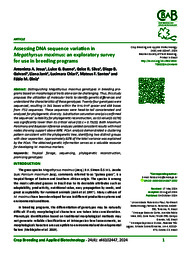Assessing DNA sequence variation in Megathyrsus maximus: an exploratory survey for use in breeding programs.
Assessing DNA sequence variation in Megathyrsus maximus: an exploratory survey for use in breeding programs.
Author(s): JESUS, A. A.; BUENO, L. G.; SILVA, G. R.; GALVANI, D. B.; JANK, L.; CHIARI, L.; SANTOS, M. F.; DINIZ, F. M.
Summary: Abstract: Distinguishing Megathyrsus maximus genotypes in breeding programs based on morphological traits alone can be challenging. Thus, this study proposes the utilization of molecular traits to identify genetic differences and understand the characteristics of these genotypes. Twenty-four genotypes were sequenced, resulting in 341 bases within the trnL-trnF spacer and 459 bases from ITS2 sequences. These sequences were head-to-tail concatenated and analyzed for phylogenetic diversity. Substitution saturation analysis confirmed the sequences’ suitability for phylogenetic reconstruction, as ISS value (0.0279) was significantly lower than its critical value (ISS.c = 0.7523). Both Maximum Parsimony and Bayesian Inference analyses yielded consistent results with most nodes showing support above 99%. PCoA analysis demonstrated a clustering pattern consistent with the phylogenetic tree, identifying two distinct groups with clear separation. Approximately 82% of the total variance was explained by the PCoA. The obtained genetic information serves as a valuable resource for developing M. maximus markers.
Publication year: 2024
Types of publication: Journal article
Unit: Embrapa Beef Cattle
Observation
Some of Embrapa's publications are published as ePub files. To read them, use or download one of the following free software options to your computer or mobile device. Android: Google Play Books; IOS: iBooks; Windows and Linux: Calibre.
Access other publications
Access the Agricultural Research Database (BDPA) to consult Embrapa's full library collection and records.
Visit Embrapa Bookstore to purchase books and other publications sold by Embrapa.

